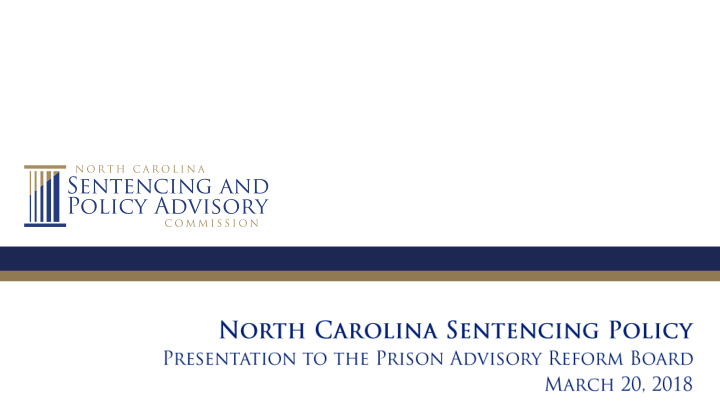



NC Sentencing and Policy Advisory Commission About Duties Membership Legislative and other requests • 28 members representing components of the criminal justice system Mandates • Monitor sentences imposed under Independent Structured Sentencing • Annual population projections • Members appointed by leaders of all three branches of government • Evaluate implementation of the Justice Reinvestment Act (JRA) • Review criminal justice bills and provide Purpose fiscal impact • Biennial recidivism reports (adult, • Advise General Assembly and criminal juvenile) justice agencies on criminal justice policy 2
Purpose of Presentation • Provide policy overview and data to inform Board’s discussion on prison reform Presentation Outline • Sentencing policies under the Structured Sentencing Act (SSA) • Policy changes under the Justice Reinvestment Act • NC Prison Population Data Sources • Department of Public Safety • NC Sentencing and Policy Advisory Commission 3
4
History of Sentencing in North Carolina Prior to 1981 • Indeterminate sentencing • Judges had wide discretionary powers • Parole Commission had ability to release prisoners at almost any point during the prison term • Probation was voluntary Fair Sentencing Act • First step towards determinate sentencing • Set presumptive prison sentences for felonies, but judges could depart from them • Gave inmates “day for day” good time • Did not control disposition • Probation was voluntary 5
Goals of Structured Sentencing Sentencing Policies Should be Truthful Sentencing Policies Should be Consistent Sentencing Policies Should be Certain Sentencing Policies Should Set Priorities for the Use of Correctional Resources Sentencing Policies Should be Balanced with Correctional Resources 6
7
8
Key Policies Under Structured Sentencing Offenders with more serious offenses and/or more extensive criminal histories receive active sentences Offenders with less serious offenses and little criminal history are more likely to receive probation sentences Offenders convicted of misdemeanor offenses and sentenced to active sentences of more than 90 days go to prison 9
Structured Sentencing Timeline 1993 2011 Enacted by the Justice Reinvestment General Assembly Act 1994 Effective for offenses committed on or after October 1 10
Justice Reinvestment Act ● Ensure that every person convicted of a felony serves a period of mandatory supervision upon release from prison. ● Limit length of time a person can be incarcerated when he or she has violated a condition of probation supervision ○ Empower probation officers to use swift and certain jail sanctions in response to violations of conditions of supervision ● Divert misdemeanors from prison 11
Key Policies Under Justice Reinvestment Offenders with more serious offenses and/or more extensive criminal histories continue to receive active sentences Fewer offenders on probation revoked for technical violations Offenders convicted of misdemeanor offenses and sentenced to active sentences go to the local jail 12
13
NC Prison Population Monthly Average: July 2003 – January 2018 44,000 Felony punishment Oct '09 Earned time chart changes 41,817 42,000 Expansion of Justice SMCP Reinvestment Act 40,000 Declines in CRV centers no criminal justice longer classified as trends prison beds but as treatment beds 38,000 FY 2006 levels 36,000 Jan '18 36,128 Jul '03 34,000 34,439 32,000 30,000 Jul Jan Jul Jan Jul Jan Jul Jan Jul Jan Jul Jan Jul Jan Jul Jan Jul Jan Jul Jan Jul Jan Jul Jan Jul Jan Jul Jan Jul Jan '03 '04 '04 '05 '05 '06 '06 '07 '07 '08 '08 '09 '09 '10 '10 '11 '11 '12 '12 '13 '13 '14 '14 '15 '15 '16 '16 '17 '17 '18 Note: Solid vertical lines separate each fiscal year. The dashed horizontal line allows for a comparison of the current prison population with historical prison populations. SOURCE: NC Department of Public Safety, Division of Adult Correction and Juvenile Justice, Daily Unit Population Reports and Inmates on Backlog Reports 14
Distribution by Offense Class: FY 1997, 2007 and 2017 FY 1997 Population: 32,529 FY 2007 Population: 38,423 FY 2017 Population: 36,317 Classes A-D = 11,057 (34%) Classes A-D = 19,372 (50%) Classes A-D = 20,756 (57%) Classes E-G = 4,427 (14%) Classes E-G = 8,846 (23%) Classes E-G = 9,095 (25%) Classes H-I = 13,059 (40%) Classes H-I = 7,077 (18%) Classes H-I = 5,888 (16%) Misdemeanors = 1,557 (5%) Misdemeanors = 1,597 (4%) Misdemeanors = 63 (0%) Other = 2,429 (7%) Other = 1,531 (4%) Other = 515 (1%) Note: Incarcerations for “Other” include pre -Fair Felons, safekeepers, and missing data. FY 2017 statistics exclude offenders represented in ASQ that are not housed in prison facilities (i.e., DWI offenders and CRV offenders housed in CRV Centers). SOURCE: NC Department of Public Safety, Division of Adult Correction and Juvenile Justice, Automated System Query (ASQ) 15
NC SPAC Prison Population Projections and Capacity FY 2018 – FY 2027 Difference Prison Population as of June 30 Prison Capacity 1 between Standard Expanded Current Fiscal Year Previous Current Operating Operating Projection End Projection Projection Capacity Capacity and EOC 2 2018 36,906 36,483 32,684 38,189 1,706 2019 37,116 36,628 32,684 38,189 1,561 2020 36,814 36,820 32,684 38,189 1,369 2021 36,821 37,115 32,684 38,189 1,074 2022 37,010 37,273 32,684 38,189 916 2023 37,268 37,488 32,684 38,189 701 2024 37,612 37,910 32,684 38,189 279 2025 38,003 38,317 32,684 38,189 -128 2026 38,442 38,840 32,684 38,189 -651 2027 N/A 39,215 32,684 38,189 -1,026 Source: NC Sentencing and Policy Advisory Commission in conjunction with the North Carolina Department of Public Safety’s Division of Adult Correction and Juvenile Justice. 1 Prison capacity estimates were provided by Prisons Administration of the NC Department of Public Safety (DPS). Capacity estimates are based on projects funded or authorized. While the state’s prisons have been operating near Expanded Operating Capacity (E OC) for many years, it should be noted that DPS bases its facility staffing levels on Standard Operating Capacity (SOC), which is the capacity that promotes a safer environment for staff and inmates. 2 Positive numbers indicate that the current projected population is lower than capacity, while negative numbers indicate that the current projected population is higher than capacity. 16
Recommend
More recommend